 Antoni de Govea, Leben, Tod und Wunder-Werck deß heiligen Joannis Dei, Prague 1711 Antoni de Govea, Leben, Tod und Wunder-Werck deß heiligen Joannis Dei, Prague 1711
The book which is a classic example of a hagiographic work and was devoted to the founder of the Merciful Brothers’ Order, St. John of God (1495-1550). Born at Monterom-o-Novo (or more precisely, Cidade) in Portugal, John of God spent his youth as a soldier, having contact with pain and suffering every day. Under the influence of these experiences and preaching of John of Avila, he was conversed and in 1539 he founded the first shelter for the sick and needy in Grenada. On the Na wave of reforms by the Council of Trent II, his work developed dynamically. During the reign of Philip II, the Merciful Brothers who were well endowed with financial resources started expanding its charismatic movement to the areas of the entire catholic Europe, bringing support and comfort everywhere. The photo presents a copper engraving with the figure of St. John of God in front of his works. |
 Jan Drachny, the view on the monastery and church of Merciful Brothers in late 18th century. Jan Drachny, the view on the monastery and church of Merciful Brothers in late 18th century.
A drawing made by Jan Drachny, graduate of the University of Vienna, later cofounder of the town hall tower in Cieszyn and architect of the Independent City of Cracow. Construction of the monastery complex in Cieszyn was completed in 1719. It was built on a hill, next to the 16th c. Church of Holy Trinity. By 1800, the monastery hospital provided shelter for 40 000 patients, out of which 37 000 had their health restored.
|
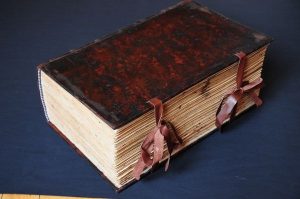 Protocollum hospitalis Teschinensis ff. Misericordiae … ab Anno 1773 Protocollum hospitalis Teschinensis ff. Misericordiae … ab Anno 1773
The register of patients of the hospital of Merciful Brothers in Cieszyn in 1773-1804, containing first and last names of the sick persons, age, confession, birth and residence places, date of registration, diagnosis, treatment method and date of checkout or death. The register, which underwent major conservation in 2009, is the greatest, in terms of volume, unit in the collections of the monastery archives (23x37x14 cm, 7 kg). The preserved documentation of the Hospital of Merciful Brothers in Cieszyn from the period between the end of 17th century and the Second World War is a very valuable source for researchers of historical demography, and indirectly for all historians dealing with the history of Cieszyn Silesia, who can use for example materials related to the range of epidemic spread in the city and its area. |
 Antoni Janusz, Daily, Annual and Life Work of Every Catholic Christian, Cieszyn 1857 Antoni Janusz, Daily, Annual and Life Work of Every Catholic Christian, Cieszyn 1857
Until the middle 19th century, both in catholic and evangelical churches in Cieszyn Silesia hymn books in Czech language were used. The breakthrough was the publication of the hymn book compiled by the rector of Zebrzydowice, Priest Antoni Janusz (1820-1861) in 1857. Despite the use of Latin fonts, not used earlier in publications for common people, that prayer book was very popular among the believers and reissued many times, already in the 19th century in most of the area of Cieszyn Silesia it replaced the books written in Czech. |
 Gaspar Erhard, Kristusovo življenje in smert v premišljevanjich in molitvach, V Celovcu 1873 Gaspar Erhard, Kristusovo življenje in smert v premišljevanjich in molitvach, V Celovcu 1873
Prayer book published in Klagenfurt (Celovec) written in Carinthian language, which is considered a Slovenian dialect by some linguists and a separate language by others, today classified as extinct. The author of the prayer book, Caspar (Gaspar) Erhard (1670–1743), already in the middle 19th century was one of the best known theologians within the area of German culture influence. |
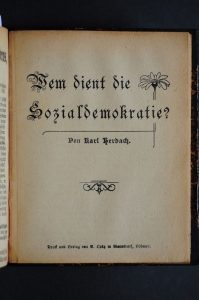 Karl Herdach, Wem dient die Sozialdemokratie?, Warnsdorf [1898] Karl Herdach, Wem dient die Sozialdemokratie?, Warnsdorf [1898]
An example of one of the many high-volume brochures from the turn of 19th and 20th centuries discussing the new, at that time, notions of social democracy, anarchy or communism. Due to the ephemeral quality of such print, not many of the copies are preserved today. The existence of this print in the collections of Cieszyn’s Merciful Brothers is a proof that the brothers, whose charismatic movement is focused on helping the sick and needy, also dealt with new philosophical and political trends. There are many similar brochures and leaflets, describing the ideological disputes of the 19th century in the library of Cieszyn’s Merciful Brothers.
|
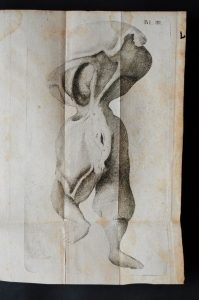 Christian Friedrich Daniel, Sammlung medicinischer Gutachten und Zeugnisse über Besichtigungen und Eröffnungen todter Körper etc., Leipzig 1776 Christian Friedrich Daniel, Sammlung medicinischer Gutachten und Zeugnisse über Besichtigungen und Eröffnungen todter Körper etc., Leipzig 1776
The work by a German doctor, Ch. F. Daniel, with posthumous publication by his 23 year-old son with the same name. Ch. F. Daniel was born on the 13th of September 1714 in Sondershausen; he studied medicine in Jen and Halle. Later, he was an academic lecturer of anatomy in Halle and a court doctor for dukes von Schwarzburg-Sondershausen. He was also interested in pregnancy pathologies. Sammlung medicinischer Gutachten, which is a part of a rich collection of medical books held by Cieszyn’s Merciful Brothers, contains a rich graphical material. The reproduction presents a deformed human foetus. |
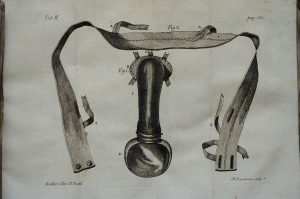 August Gottlieb Richter, Anfangsgründe der Wundarzneykunst, Vienna 1799 August Gottlieb Richter, Anfangsgründe der Wundarzneykunst, Vienna 1799
August Gottlieb Richter (1742-1812) was one of the most renowned and best-known German surgeons of the turn of the 18th and 19th centuries. He carried own his research on the University of Gottingen. The book kept in the library of Cieszyn’s Merciful Brothers is the sixth of all seven volumes of the publication, which was the basic resource for surgery not only in Germany but also abroad. The work includes charts presenting surgery tools used in the second half of the 18th century. |
 Ludwik Perzyna, Barber Surgery Sciences in Short… Part II, Kalisz 1793 Ludwik Perzyna, Barber Surgery Sciences in Short… Part II, Kalisz 1793
Friar Ludwik Perzyna (1742-1800), a Merciful Brother, was one of the first Polish authors discussing the primary surgery principles. According to some transmissions, he spent some time in Cieszyn. His Barber Surgery Sciences was the most popular surgery book among the Polish Merciful Brothers. |
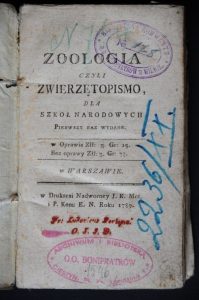 Zoology or Animals Magazine, published for the national schools for the first time, Warsaw 1789 Zoology or Animals Magazine, published for the national schools for the first time, Warsaw 1789
The book is stamped with the seal of Ludwik Perzyna, which may indicate that it belonged to his large collection of books related to medicine and natural sciences. The greatest part of this book collection is currently kept in the Library of the City of Warsaw. The presented item contains a contemporary handbook on zoology. Its content is illustrated with five meticulous charts presenting both animals and human anatomy. An interesting element is the seal of the Library of Merciful Brothers’ Order of Vilnius, which confirms the complicated history of books that used to belong to the collection of Ludwik Perzyna. |









